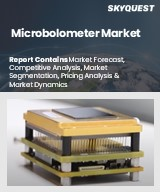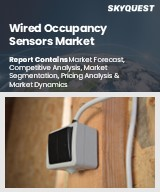
|
시장보고서
상품코드
1758555
마이크로볼로미터 시장 규모, 점유율 및 성장 분석(기술별, 재료별, 해상도별, 픽셀 피치별, 파장별, 용도별, 최종 사용자별, 지역별) : 산업 예측(2025-2032년)Microbolometer Market Size, Share, and Growth Analysis, By Technology, By Materials, By Resolution, By Pixel Pitch, By Wavelength, By Application, By End-User, By Region - Industry Forecast 2025-2032 |
||||||
세계의 마이크로볼로미터 시장 규모는 2023년 4억 1,501만 달러로 평가되었으며, 2024년 4억 4,531만 달러에서 2032년에는 7억 8,245만 달러로 성장하며, 예측 기간(2025-2032년)의 CAGR은 7.3%를 나타낼 전망입니다.
세계의 마이크로볼로미터 시장은 방위, 자동차, 산업, 가전의 각 분야에 있어서의 적외선 이미징 기술 수요 증가에 견인되어 강력한 성장을 이루고 있습니다. 마이크로볼로미터는 비냉각 적외선 검출기로 밤비전, 감시, 예지보전 등의 용도에 비용 효율적인 콤팩트한 솔루션을 제공합니다. 자동차 분야에서는 ADAS와 자율주행 시스템을 위한 열 센서의 통합이 진행되고 있어 시장 확대를 더욱 뒷받침하고 있습니다. 시장은 또한 온도 스크리닝이나 화재 검지, 특히 팬데믹 후의 용도 확대로부터도 혜택을 받고 있어 장기적인 성장 전망이 지속되고 있는 것을 나타내고 있습니다.
목차
서론
- 분석 목적
- 시장 범위
- 정의
분석 기법
- 정보 조달
- 2차·1차 데이터의 수법
- 시장 규모 예측
- 시장의 상정과 제약
주요 요약
- 시장 개요와 전망
- 수급 동향의 분석
- 부문별 기회 분석
시장 역학과 전망
- 시장 개요
- 시장 규모
- 시장 역학
- 성장 촉진요인과 기회
- 성장 억제요인과 과제
- Porter's Five Forces 분석
시장의 주요 인사이트
- 주요 성공 요인
- 경쟁도
- 주요 투자 기회
- 시장 생태계
- 시장 매력도 지수(2024년)
- PESTEL 분석
- 거시경제지표
- 밸류체인 분석
- 가격 분석
세계의 마이크로볼로미터 시장 규모·CAGR : 기술별(2025-2032년)
- 시장 개요
- 바나듐 산화물(VOx)
- 비정질 실리콘(a-Si)
- 기타 재료
세계의 마이크로볼로미터 시장 규모·CAGR : 재료별(2025-2032년)
- 시장 개요
- 비정질 실리콘(a-Si)
- 산화 바나듐(VOX)
세계의 마이크로볼로미터 시장 규모·CAGR : 해상도별(2025-2032년)
- 시장 개요
- 저해상도
- 중해상도
- 고해상도
- 초고해상도
세계의 마이크로볼로미터 시장 규모·CAGR : 픽셀 피치별(2025-2032년)
- 시장 개요
- 25μm 이상
- 17-25μm
- 12-17μm
- 12μm 이하
세계의 마이크로볼로미터 시장 규모·CAGR : 파장별(2025-2032년)
- 시장 개요
- 단파 적외선(SWIR)
- 중파 적외선(MWIR)
- 장파 적외선(LWIR)
세계의 마이크로볼로미터 시장 규모·CAGR : 용도별(2025-2032년)
- 시장 개요
- 자동차 시스템
- 군사 및 방위
- 산업 모니터링
- 상업 용도
- 의료 영상
- 가전
세계의 마이크로볼로미터 시장 규모·CAGR : 최종 사용자별(2025-2032년)
- 시장 개요
- 정부기관
- 민간기업
- 연구기관
- 교육기관
- 의료 제공업체
세계의 마이크로볼로미터 시장 규모·CAGR(2025-2032년)
- 북미
- 미국
- 캐나다
- 유럽
- 독일
- 스페인
- 프랑스
- 영국
- 이탈리아
- 기타 유럽
- 아시아태평양
- 중국
- 인도
- 일본
- 한국
- 기타 아시아태평양
- 라틴아메리카
- 브라질
- 기타 라틴아메리카
- 중동 및 아프리카
- GCC 국가
- 남아프리카
- 기타 중동 및 아프리카
경쟁 구도
- 상위 5개사 비교
- 주요 기업의 시장 포지셔닝(2024년)
- 주요 기업이 채용한 전략
- 시장의 최근 동향
- 주요 기업의 시장 점유율(2024년)
- 주요 기업 프로파일
- 기업 개요
- 제품 포트폴리오 분석
- 부문별 점유율 분석
- 수익의 전년대비 비교(2022-2024년)
주요 기업 프로파일
- Lynred(France)
- Leonardo DRS(United States)
- BAE Systems Imaging Solutions(United Kingdom)
- INFRATEC GmbH(Germany)
- IRay Technology Co., Ltd.(China)
- Tonbo Imaging(India)
- Sofradir EC, Inc.(United States)
- New Imaging Technologies(NIT)(France)
- Seek Thermal Inc.(United States)
- Xenics NV(Belgium)
- Teledyne FLIR(OEM Microbolometer Division)(United States)
- Opgal Optronic Industries Ltd.(Israel)
- Sierra-Olympic Technologies Inc.(United States)
- Magnity Electronics Co., Ltd.(China)
- Zhejiang Dali Technology Co., Ltd.(China)
- Nippon Avionics Co., Ltd.(Japan)
- Testo SE & Co. KGaA(Germany)
- InfraTec Infrared Sensor GmbH(Germany)
- Aselsan AS(Turkey)
- Guide Sensmart Tech Co., Ltd.(China)
결론과 권고
KTH 25.07.03Global Microbolometer Market size was valued at USD 415.01 million in 2023 and is poised to grow from USD 445.31 million in 2024 to USD 782.45 million by 2032, growing at a CAGR of 7.3% during the forecast period (2025-2032).
The Global Microbolometer Market is witnessing robust growth, driven by rising demand for thermal imaging technologies across defense, automotive, industrial, and consumer electronics sectors. Microbolometers, as uncooled infrared detectors, offer cost-effective and compact solutions for applications such as night vision, surveillance, and predictive maintenance. Technological advancements are enhancing resolution, sensitivity, and integration with AI and IoT, fueling broader adoption. The automotive sector is increasingly integrating thermal sensors for ADAS and autonomous driving systems, further propelling market expansion. Additionally, increased defense budgets and the growing need for border surveillance are accelerating military-grade microbolometer deployments. The market is also benefiting from expanding use in temperature screening and fire detection, especially post-pandemic, indicating sustained long-term growth prospects.
Top-down and bottom-up approaches were used to estimate and validate the size of the Global Microbolometer market and to estimate the size of various other dependent submarkets. The research methodology used to estimate the market size includes the following details: The key players in the market were identified through secondary research, and their market shares in the respective regions were determined through primary and secondary research. This entire procedure includes the study of the annual and financial reports of the top market players and extensive interviews for key insights from industry leaders such as CEOs, VPs, directors, and marketing executives. All percentage shares split, and breakdowns were determined using secondary sources and verified through Primary sources. All possible parameters that affect the markets covered in this research study have been accounted for, viewed in extensive detail, verified through primary research, and analyzed to get the final quantitative and qualitative data.
Global Microbolometer Market Segments Analysis
Global Microbolometer Market is segmented by Technology, Materials, Resolution, Pixel Pitch, Wavelength, Application, End-User and region. Based on Technology, the market is segmented into Vanadium Oxide (VOx), Amorphous Silicon (a-Si) and Other Materials. Based on Materials, the market is segmented into Amorphous Silicon (a-Si) and Vanadium-oxide (VOX). Based on Resolution, the market is segmented into Low Resolution, Medium Resolution, High Resolution and Ultra-High Resolution. Based on Pixel Pitch, the market is segmented into Above 25μm, 17-25μm, 12-17μm and Below 12μm. Based on Wavelength, the market is segmented into Short-Wave Infrared (SWIR), Mid-Wave Infrared (MWIR) and Long-Wave Infrared (LWIR). Based on Application, the market is segmented into Automotive Systems, Military & Defense, Industrial Monitoring, Commercial Applications, Medical Imaging and Consumer Electronics. Based on End-User, the market is segmented into Government Agencies, Private Enterprises, Research Institutions, Educational Organizations and Healthcare Providers. Based on region, the market is segmented into North America, Europe, Asia Pacific, Latin America and Middle East & Africa.
Driver of the Global Microbolometer Market
The Global Microbolometer market is significantly driven by the rising demand for advanced security, night vision, and surveillance solutions within the defense and military sectors. Microbolometers play an essential role in enhancing situational awareness, facilitating effective surveillance, and enabling target detection in low-light or total darkness conditions. Their capacity to recognize heat signatures provides crucial advantages for military operations, including perimeter security and border defense. This growing need is spurring innovation in microbolometer sensor technology tailored for defense applications, highlighting their importance in modern military strategies and technologies, thereby propelling the market forward.
Restraints in the Global Microbolometer Market
A major challenge hindering the global microbolometer market is the high cost of production, particularly for those utilizing vanadium oxide (VOx). The expense associated with developing thermal imaging devices leads to elevated prices, which poses a barrier to broader market penetration and acceptance, particularly in price-sensitive sectors. Consequently, this limits the accessibility of microbolometer-based products in cost-driven markets and emerging economies, making them less affordable for potential users. As a result, the high production costs of microbolometers can significantly impact their adoption rates, especially in regions where budget constraints are a primary consideration.
Market Trends of the Global Microbolometer Market
The Global Microbolometer market is witnessing a notable trend towards the integration of microbolometers in consumer products, driven by the growing demand for compact, portable technologies. This trend is reflected in the increasing adoption of microbolometers in wearables, smartphones, and automotive systems, aiming to enhance functionalities such as security, health monitoring, and personal safety. The miniaturization of these thermal imaging sensors not only improves their usability in everyday devices but also promotes their affordability, thereby expanding market accessibility. As consumer electronics continue to evolve, microbolometers are becoming essential components, positioning themselves at the forefront of technological advancements in various industries.
Table of Contents
Introduction
- Objectives of the Study
- Scope of the Report
- Definitions
Research Methodology
- Information Procurement
- Secondary & Primary Data Methods
- Market Size Estimation
- Market Assumptions & Limitations
Executive Summary
- Global Market Outlook
- Supply & Demand Trend Analysis
- Segmental Opportunity Analysis
Market Dynamics & Outlook
- Market Overview
- Market Size
- Market Dynamics
- Drivers & Opportunities
- Restraints & Challenges
- Porters Analysis
- Competitive rivalry
- Threat of substitute
- Bargaining power of buyers
- Threat of new entrants
- Bargaining power of suppliers
Key Market Insights
- Key Success Factors
- Degree of Competition
- Top Investment Pockets
- Market Ecosystem
- Market Attractiveness Index, 2024
- PESTEL Analysis
- Macro-Economic Indicators
- Value Chain Analysis
- Pricing Analysis
Global Microbolometer Market Size by Technology & CAGR (2025-2032)
- Market Overview
- Vanadium Oxide (VOx)
- Amorphous Silicon (a-Si)
- Other Materials
Global Microbolometer Market Size by Materials & CAGR (2025-2032)
- Market Overview
- Amorphous Silicon (a-Si)
- Vanadium-oxide (VOX)
Global Microbolometer Market Size by Resolution & CAGR (2025-2032)
- Market Overview
- Low Resolution
- Medium Resolution
- High Resolution
- Ultra-High Resolution
Global Microbolometer Market Size by Pixel Pitch & CAGR (2025-2032)
- Market Overview
- Above 25μm
- 17-25μm
- 12-17μm
- Below 12μm
Global Microbolometer Market Size by Wavelength & CAGR (2025-2032)
- Market Overview
- Short-Wave Infrared (SWIR)
- Mid-Wave Infrared (MWIR)
- Long-Wave Infrared (LWIR)
Global Microbolometer Market Size by Application & CAGR (2025-2032)
- Market Overview
- Automotive Systems
- Military & Defense
- Industrial Monitoring
- Commercial Applications
- Medical Imaging
- Consumer Electronics
Global Microbolometer Market Size by End-User & CAGR (2025-2032)
- Market Overview
- Government Agencies
- Private Enterprises
- Research Institutions
- Educational Organizations
- Healthcare Providers
Global Microbolometer Market Size & CAGR (2025-2032)
- North America (Technology, Materials, Resolution, Pixel Pitch, Wavelength, Application, End-User)
- US
- Canada
- Europe (Technology, Materials, Resolution, Pixel Pitch, Wavelength, Application, End-User)
- Germany
- Spain
- France
- UK
- Italy
- Rest of Europe
- Asia Pacific (Technology, Materials, Resolution, Pixel Pitch, Wavelength, Application, End-User)
- China
- India
- Japan
- South Korea
- Rest of Asia-Pacific
- Latin America (Technology, Materials, Resolution, Pixel Pitch, Wavelength, Application, End-User)
- Brazil
- Rest of Latin America
- Middle East & Africa (Technology, Materials, Resolution, Pixel Pitch, Wavelength, Application, End-User)
- GCC Countries
- South Africa
- Rest of Middle East & Africa
Competitive Intelligence
- Top 5 Player Comparison
- Market Positioning of Key Players, 2024
- Strategies Adopted by Key Market Players
- Recent Developments in the Market
- Company Market Share Analysis, 2024
- Company Profiles of All Key Players
- Company Details
- Product Portfolio Analysis
- Company's Segmental Share Analysis
- Revenue Y-O-Y Comparison (2022-2024)
Key Company Profiles
- Lynred (France)
- Company Overview
- Business Segment Overview
- Financial Updates
- Key Developments
- Leonardo DRS (United States)
- Company Overview
- Business Segment Overview
- Financial Updates
- Key Developments
- BAE Systems Imaging Solutions (United Kingdom)
- Company Overview
- Business Segment Overview
- Financial Updates
- Key Developments
- INFRATEC GmbH (Germany)
- Company Overview
- Business Segment Overview
- Financial Updates
- Key Developments
- IRay Technology Co., Ltd. (China)
- Company Overview
- Business Segment Overview
- Financial Updates
- Key Developments
- Tonbo Imaging (India)
- Company Overview
- Business Segment Overview
- Financial Updates
- Key Developments
- Sofradir EC, Inc. (United States)
- Company Overview
- Business Segment Overview
- Financial Updates
- Key Developments
- New Imaging Technologies (NIT) (France)
- Company Overview
- Business Segment Overview
- Financial Updates
- Key Developments
- Seek Thermal Inc. (United States)
- Company Overview
- Business Segment Overview
- Financial Updates
- Key Developments
- Xenics NV (Belgium)
- Company Overview
- Business Segment Overview
- Financial Updates
- Key Developments
- Teledyne FLIR (OEM Microbolometer Division) (United States)
- Company Overview
- Business Segment Overview
- Financial Updates
- Key Developments
- Opgal Optronic Industries Ltd. (Israel)
- Company Overview
- Business Segment Overview
- Financial Updates
- Key Developments
- Sierra-Olympic Technologies Inc. (United States)
- Company Overview
- Business Segment Overview
- Financial Updates
- Key Developments
- Magnity Electronics Co., Ltd. (China)
- Company Overview
- Business Segment Overview
- Financial Updates
- Key Developments
- Zhejiang Dali Technology Co., Ltd. (China)
- Company Overview
- Business Segment Overview
- Financial Updates
- Key Developments
- Nippon Avionics Co., Ltd. (Japan)
- Company Overview
- Business Segment Overview
- Financial Updates
- Key Developments
- Testo SE & Co. KGaA (Germany)
- Company Overview
- Business Segment Overview
- Financial Updates
- Key Developments
- InfraTec Infrared Sensor GmbH (Germany)
- Company Overview
- Business Segment Overview
- Financial Updates
- Key Developments
- Aselsan A.S. (Turkey)
- Company Overview
- Business Segment Overview
- Financial Updates
- Key Developments
- Guide Sensmart Tech Co., Ltd. (China)
- Company Overview
- Business Segment Overview
- Financial Updates
- Key Developments



















